The Symbolic Process and its Integration in Children
Chapter 9: The Nature of Symbolic Integration
John Fordyce Markey
Table of Contents | Next | Previous
HAVING analysed materials indicating the important part played by social behaviour in symbolic development, it will now be valuable to bring these facts together again into a more specific statement regarding the nature of symbolic integration, giving these social factors a clearer and more balanced place in the explanation. Three main conceptions are included in the term " integration." The first is the dynamic or change-aspect involved in the coming together or the emergence of a new or different organization, co-ordination, or configuration. The second is the continuity and causal aspect, in that the emergence is from or out of previously existing correlations and processes and is dependent upon these. The third is the unitary aspect, i.e., the emergent or configuration constitutes some sort of a functional unit or working whole. A co-ordination and division of labour are indicative of this aspect. The problem is simply one of indicating previous processes, and of explaining how the new organization is created and of discovering what sort of functional unit or emergent it is.
From our previous analysis it is clear that we may come to grips with the problem in the general field of social interaction and more specifically in the " complex social act," to use Mead's apt phrase. The complex social act consists of the operation of interdependent behaviour systems. It will thus be convenient, even though somewhat artificial, to take for a time the individual as a point of reference from which to observe the operation of complex social behaviour involved in the integration of symbols. That such a procedure may be quite artificial
(115) if not handled carefully is clear when it is recalled that such social activity cannot exist in separate and isolated individuals, but only in their interdependence. The attempt to actually separate persons would be somewhat analogous to the much simpler procedure of extracting the Na from the Cl in salt. Part of the result, if used properly, might be beneficial for a cold in the head, but it would hardly be used to season soup. And while studying so-called individual behaviour systems, it must be clearly kept in mind that they are not to be regarded as separate units, but as phases of social behaviour.
That the total act must be regarded as a whole, something more than a summation of parts, has been well and convincingly emphasized by the Gestalt psychologists, among others. So that the problem is not so much one of tearing the symbolic process to pieces as one might a watch and then pointing to the pieces as a description of a watch, as it is of discovering the processes at work which are involved in the emergence of symbols in behaviour.
Before going into the problem more specifically, it seems necessary to point out certain characteristics of symbols which must be taken into consideration. The symbol involves the use by the organism of some act or sign which is differentiated from, but at the same time is a substitute for, an act or object. It is necessary to emphasize this point in order to show the inadequacy of an explanation of symbolic origin which is apt to appear valid upon casual examination, but which really does not give the necessary facts with which to account for the origin of symbols. The theory runs somewhat as follows : It assumes that symbols might have arisen through gestures, perhaps facial or hand gestures. Suppose two apes attempt to eat an extremely pungent fruit and make facial contortions of disgust. Thus, mutually observing each other, this particular grimace gets to symbolize a disgust of distasteful fruit. Such behaviour, however, is inadequate to account for the development of a symbol. First, we must differentiate between signs and symbols. The sign is an event which, due to its association with some other event or
( 116) object, signalizes the latter. There is a large group of stimuli which function in this manner. The danger calls and the sex calls of animals are examples. The hen's pecking is a sign to the chick to peck. Of course, it is clear that these signs are not objects of reflection for these animals. It is only to animals with symbols that these signs become objects of reflection. For other animals they exist as stimuli, often conditioned stimuli which arouse responses. Just as in the case of Clever Hans, for example, the reaction of the audience when he had counted the proper number, was a sign, or conditioned stimulus for him to stop. These aspects of conditioned and unconditioned response are so familiar that no more need be added to show how clearly they can account for gesture signs without implying symbolic reference.
It is undoubtedly true that signs are prior to and form an easy framework for the development of symbols. Ogden and Richards (1923) have very convincingly discussed the fundamental characteristics of the sign situation.
What is lacking in the above gesture situation is this, the ape by his behaviour does not set off the grimace or gesture as separate from, but symbolizing the bitter fruit. He responds to both on their own account as stimuli. The ape does not stimulate himself with the gesture and react to it as representing a bitter object. In order for him to do this, there would have to be more similarity-enough, in fact, for his own stimulus to stimulate himself just as the other ape's gesture does. He cannot see his own grimace, or if it were a gesture, it would not appear to him as similar to the other ape's gesture, and consequently, could not be substituted for or symbolize the gesture of the other ape ; much less could it symbolize the fruit. He reacts to the other's stimulus as a conditioned stimulus, not as a stimulus representing the bitter object. What would be necessary in order to complete the symbol from the sign is that the ape should be able to stimulate himself with a stimulus so similar to the gesture of the
( 117) other ape that he would arouse responses to his own act setting it off as different from the other, and at the same time arousing the responses which differentiate the act as that of the other, thus dividing the behaviour system into two reacting parts which give the symbol its symbolic character. The social-vocal-auditory situation makes this possible. It may be due to the peculiarities of bodily structure that it is the vocal response which is thus interchangeable, and certainly any other such consistently interchangeable stimulus might also perform this function in animals with a sufficiently developed nervous system, but so far as we know there are no other such stimuli, except the vocal responses, that existed before vocal language developed in social behaviour. Of course, after symbols were once integrated, it became possible to produce similar interchangeable characteristics in other stimuli than the vocal ones. In any case the social situation remains a prime essential.
It is due to this method of developing symbols that all our symbols are acquired indirectly. But the significance of this point will be taken up later, as it can hardly be overemphasized.
As some of the aspects of conditioned response in relation to symbolic integration have already been discussed in Chapter III, the problem may again be taken up at this point.
In resume, the situation is somewhat as follows. The S-R (stimulus-response) relationship functions in a biological or organic process. With the life process, as observed in less complex organisms, and to a large degree in man, scientists have demonstrated balanced functional (mathematically speaking) relationships. Psychologically, we may state it in the elementary formula R f S or S f R. From this we may proceed to the more specific aspect involving the symbolic process.
The symbolic process is the use of a substitute stimulus or response for the elementary terms in this equation. Not all substitution of S or R is symbolic. There is the
( 118) more simple-conditioned response type of substitution which may be put in a formula as follows:
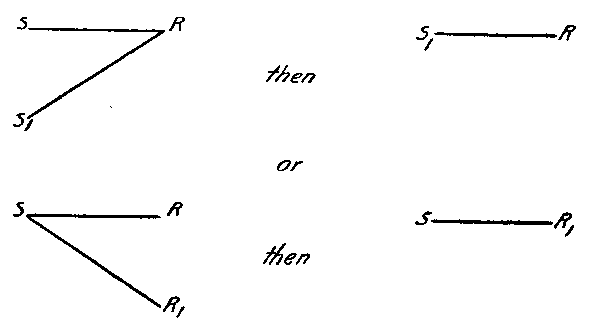
There is reason to believe that this conditioning process may go on to a rather
refined degree where S2 is substituted for S1, S3
for S2, etc., and similarly for R. The degree of conditioning would
vary with different types of response, but there are limitations.We could hardly
expect to get a person conditioned to enjoy strenuous electric shocks. The type
of substitution in the symbolic behaviour is one in which a third factor is
introduced by more complex conditioning and remains as a substitute for the S
and R, as shown in the figure.
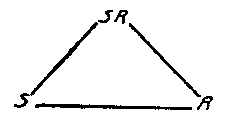
The essential difference is that in the previous type of substitution the S defines the R and the R defines the S. They are defined in terms of each other, whereas the SR defines the S and R in a third term including processes of both S and R.The functional relationship still maintains.
At this point certain qualifications must be made regarding the conditioned response.No such thing exists
( 119) in the isolated manner in which it is juggled about by some psychologists. Neither stimuli nor responses exist separately. These are merely devices for observing and measuring behaviour and after use must be thrown back into the dynamics of behaviour units and wholes. Too often they give little inkling of how the whole actually performs or what it is. If this process of conditioning responses is thought of as one in which one figure is merely replaced by another as in a simple algebraic formula, or as a mere summation of parts, such a conception must be discarded. And if the concept of conditioned response carries only this theory, it must also follow to the same scrap heap.Some psychologists, in their attempt to place psychology upon a sound scientific basis, have oversimplified psychological processes by making such phenomena as conditioning a matter of the simple substitution of one response or stimulus for another, as one might substitute lettuce for onions at a meal.
It seems that a good share of the argument centring around mechanism, vitalism and the like resolves itself into such oversimplification, or if the oversimplification is not intended it is imputed and the consequent attack is as violent as if the straw figure were a real one. Of course, in addition to all these unduly simplified explanations are a whole list of conjurations which add unwarranted complexity, mystification, and confusion to psychological description.
In view of this state of affairs it seems advisable that this problem of the mechanistic or non-mechanistic character of behaviour processes should be tackled at once in order to properly clarify the following discussion.
Some have regarded mechanistic, when applied to behaviour processes, as involving a static condition such as is found in a machine. Everything that the machine can do already exists in its organization. The thing is made and stays put-nothing new develops in its operation. Thus the term mechanistic has implied a form of contact such as seen in the contact of the cogs of a gear wheel, and not as the contact of an electric spark with a high explosive,
( 120) for instance. They have tended to treat mechanistic as meaning mere contact without the realization that there is no such thing as contact abstracted from what takes place when contact occurs. They have neglected to look at contact as initiating interaction. Mechanistic has been regarded as indicative of a mere additive or a simple multiplication process. However, it is setting up something of a straw man to say in general that those who attempt a mechanistic explanation of behaviour intend to use the term in such a limited sense. By numerous writers it is merely used to indicate a dependent or sequential relationship, sometimes called a causal relationship, and nothing more. The term " mechanistic " is sometimes preferable to " causal " on account of the fact that we are not sure what actually " causes " phenomena to occur. Scientifically, it cannot be said with certainty that one event causes another. We merely know inductively that certain events always occur together or in sequence, in a functional relationship. Thus the term" cause" is apt to carry a mythical content which " mechanistic " does not do. Further, mechanistic when used in psychology is apt to mean the implication of a physical and chemical basis for life and behaviour processes. Now, while this cannot be proven for a large number of phenomena, it has such a preponderance of scientific evidence behind it that it is a justified hypothesis until it is proven inadequate, not merely by showing processes still unexplained, but by showing contrary facts.
Mechanistic, then, when used with the idea of a dependent functional relationship, can hardly have objections brought against it on this score by the scientific man. When it is also regarded as an hypothesis which assumes a physical and chemical basis for life and behaviour processes, it may be open to more serious objection in the minds of some. However, such an hypothesis can scarcely be rejected as a working basis in biology and psychology until its opponents have demonstrated on scientific grounds its inadequacy.
Thus, when mechanistic is used here, it carries these
( 121) two implications : the existence of dependent functional relationships, and the hypothesis of a physical and chemical basis for life and behaviour processes. It does not imply that new wholes and new configurations, i.e., invention or creation and discovery, are not facts of science, nor does it imply that we necessarily find these new integrations in isolated parts or their mere summation.
With this conception clarified, the discussion may return to the conditioned response.
It is probable that the conditioned response conception cannot be relied upon to give an adequate idea of symbolic integration on account of its encumbrance with such a conception as mathematical substitution instead of mathematical multiplication and even more complex dependence. By a more complex dependence is meant such a situation, for example, as is given when different chemical substances result in a third which is more than the mere addition of i + 2. Behaviour integrations are apparently often much more complex than this.
In going beyond or behind the conditioned response conception, there is no intention of regarding it as invalid when properly understood and used. Conditioning is, on the contrary, a demonstrable fact, and plays an important part in symbolic integration, as already indicated. The following analysis should put more content into it.
As hinted before, we do not know the " real nature " of what happens in irritable cells, particularly nerve cells, upon stimulation any more than we know the " real nature" of electricity. Our greatest advance has been in describing and explaining their activity and behaviour, in showing the physical, chemical or electrical aspect of their processes, in formulating laws, and in establishing theories and hypotheses which most adequately account for the observed facts.
It would take the present study too far out of its present limits to go into all this material, relating to physiological and behaviour processes, in order to give an adequate idea of the complex behaviour systems which form an integral part of symbolic integration. The writings of such
( 122) scientists as Child, Herrick, Loeb, Jennings, Sherrington, Lashley, Semon, Pavlov, Cannon, and many others are mines of physiological and behaviouristic information regarding these phenomena. Only some brief points may be emphasized.
The organism is some sort of energetic system with excitation-irritability characteristics. As a result of stimulation and excitation, material changes or traces are left in the cells of the body. Semon has used the term engram-" an enduring material change of the irritable substance " which remains behind and, though latent, " can be roused to manifestation at any moment in conformity with known laws " (1921, P. 273)-to designate this result. The rearousal of the mnemic trace or engram from its latent state he calls ecphory (1921, p. 12). Engramic effects are distinct from each other, but all of those stimuli occurring simultaneously leave behind engrams in juxtaposition which are coherently associated; i.e., an engramic complex. Engrams also successively tie into each other in a continuous unilinear manner. Each separate stimulus, although of the same kind, leaves its separate engram. In using the term " engram " there is no intention of subscribing to a too structural conception of such physiological changes. These physiological changes which are left and facilitate a subsequent rearousal and reoccurrence of responses is all that is intended by the use of the term. The continuous change and reshaping which goes on in behaviour patterns, their non-specific character, is well emphasized by Child (1924).This work should be read as an antidote to a too structural conception of engramic changes.
Thus any of the more differentiated organisms represent very intricate organization of engramic complexes. Child and Herrick have shown how the more irritable parts of the cell dominate by gradients over the rest of the cell, and also that the more irritable cells and parts of the body establish excitation-gradients over the rest. Such central dominance over engramic complexes gives the organism a remarkable ability of response and adjustment in co-ordin-
( 123) -ating ecphorized engramic or mnemic excitation with present original. stimulation.
These processes occur among all organisms and it should be emphasized that activity which is non-symbolic is often very complex and highly integrated. This latter point is particularly important, for when these processes occur among other animals they are accepted under causal rubrics, but when they appear in man they are often treated as though they had taken on a mysterious something which defies causal analysis. While it is very essential that these processes be explained on their own account, they are for the present accepted as given; the problem is to explain the additional integration involved in the development of symbols. It is probably much more difficult to explain the ordinary complex activity of so-called higher animals than given this to show the further integration resulting in symbolic emergents.
These complex behaviour systems exist only in social groupings of some sort. This fact makes possible a much more intricate organization of behaviour. Individual behaviour systems are not independent, but become in our more complex grouping mere " truncated acts," the complete or " whole " process existing only in the group and not in the individual as such. In this sense it is legitimate to speak of a group unity and proceed to analyse the group behaviour as a group process and not as a bunch of separate individuals. This, of course, must not be taken to mean that this group exists separate or apart from individuals, it is an interrelation of individuals. It is in such social situations and behaviour systems that symbolic integration occurs.
Figures B, C and D are given as suggestive of symbolic integration. They give a simple representation of a complex social act in which the hungry child reacts vocally, the mother comes with food, also responding vocally, and the child is fed. Figure B shows the complex social act as it might exist with slight modifications in a more or less complicated form in a large number of different animal groups. This may represent pre-symbolic behaviour on
( 124) the part of both organisms involved, if we assume M1 and M2 to be mere vocalizations. As a basis for symbolic integration, it would be necessary for these vocalizations to be sufficiently similar to be interchanged, as is seen in children's behaviour, and which undoubtedly marked
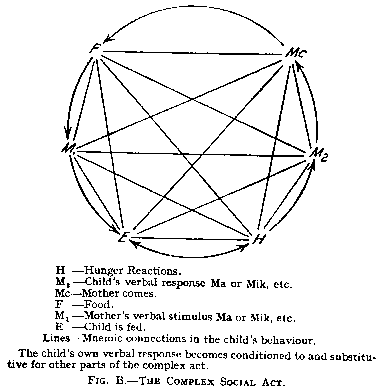
symbolic beginning in the race as well. The interconnecting lines represent the interconnections of the act in the child's behaviour system. They represent engrams or physiological modifications in juxtaposition, forming, a whole engramic-complex of mnemic traces which may be ecphorized by any one of the associated or conditioned stimuli as well as by certain states of organic excitement.[1]
(125)
Figure C represents more explicitly the child's present original responses associated with ecphorized mnemic excitation of engramic-complexes. During the child's babbling period repetition after repetition of such stimulation occurs. Similar mnemic revival occurs together with present original stimulation and the two interact, adjust and strengthen each other (see an explanation of homophony by Semon, 1921).
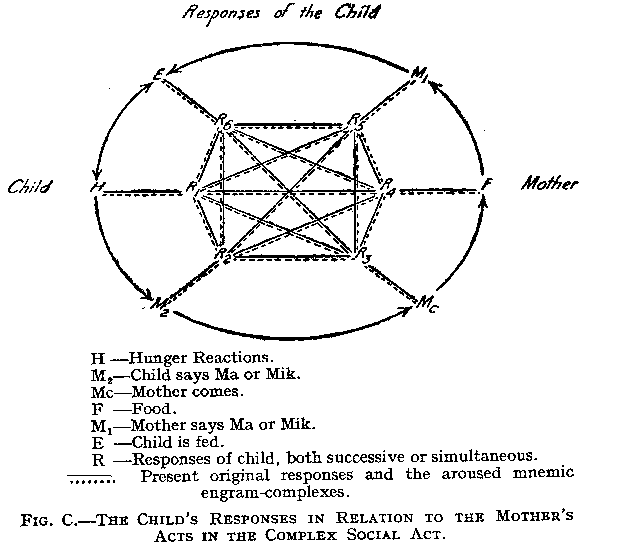
Figure D illustrates the integration of the symbol when the child's vocal response has been interchanged with that of the mother. The child thus arouses its engramic and original present responses to its mother, but also arouses its engramic and original present responses to itself. Such behaviour processes as facilitation, irradiation, more than mere additive summation and gradiential domination, are very significant aspects of such behaviour.
(126) The child performs his own part of the complex act and at the same time performs another's part as well. The engramic arousal and beginning responses of the child toward the mother's stimulus for which its vocal response has been substituted, are thus directed toward another part of its own behaviour mechanisms consisting of further engramic and original present responses. These two configurations or parts of behaviour, from their simultaneous
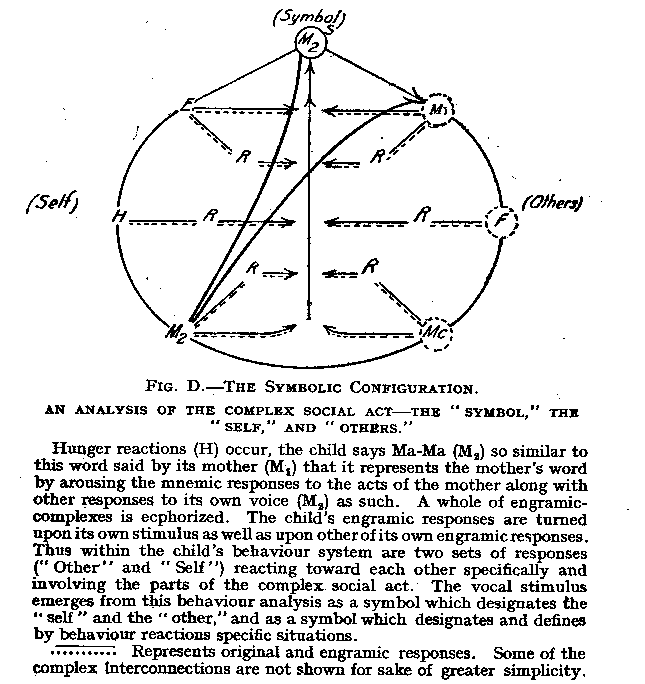
interaction serve to mark off, or analyse, the parts of the complex social act. The interchanged stimulus is thus designated by behaviour reactions as representing, while
( 127) still distinct from, the mother's part of the social act. It is also similarly representative of the child's own behaviour. This constitutes it as a symbol. It is thus that the stimulus which arouses the " self " and " other" aspects of behaviour, emerges as a symbol of these parts and as a behaviour analysis of the situation. This process, by which symbols emerge and operate, is what is meant by the symbolic process. It should also be remembered that emotional responses of the child are very important in symbolic integration. Practically all responses either are or become more or less emotional in character. The situation, including parental or similar associations, in which the child lives, is ordinarily one of strong emotional interaction and conditioning. Much more study of emotional responses is necessary, but sufficient is known regarding them to testify to their outstanding importance in motivating activity and also in the fixation and conditioning of responses. Thus the extensive role played by emotional responses in symbolic integration is one of greatly facilitating such development.
Symbols at first are apparently used for all similar situations to which they may apply, and to designate the whole event. It is only by further social interaction that symbols are disintegrated and new ones integrated or redintegrated to designate more specific parts of the act or situation.
The validity of the symbol depends upon the complex act. Particularly must the specific part interchanged, i.e., the vocalization, be consistently configurated and conditioned with the act by the behaviour mechanisms of both persons ; otherwise it would have such an insecure place in the co-ordination that it would neither serve as a symbol nor as a means of interchange. If the complex social act or object becomes changed or modified so that it is no longer sufficiently consistent with the symbolic configuration, the symbolic character of the configuration is destroyed. The result is that a new symbol must be integrated which does answer consistently to the parts of the act. These are essential characteristics of it as a
( 128) symbol, and mean that the symbol is essentially a social and common product dependent in the final analysis upon its social character.
Just what a symbol and its content will be cannot be predicted beforehand, for it is yet in process of construction. For the individuals concerned to know ahead of time or before the symbol is integrated what it is to be is a contradiction of terms.
From this standpoint the symbolic process can never be catalogued as mechanistic, if by such a term is meant machine-like addition or summation. It is essentially inventive or creative in operation. The fact that the content of the symbol is unpredictable until it is once integrated has reference primarily to its first genesis. But even before a symbol has ever existed, some of the content is predictable in a limited sense, if previous symbols by their nature must form some of the phases of the new symbol. After the symbol once emerges, it may then be explained mechanistically in a causal sense with the presupposition of a chemical and physical basis. And other similar symbols may be produced or predicted under similar conditions. That is, while the specific symbolic configuration may be unpredictable until known, still its integration is to be explained causally and as involving a functional relationship. And given a knowledge of and acquaintance with a person, a social psychologist can often predict the symbolic configuration which will result from a new problem presented to a subject, and certainly so if he knows all the factors which will come into consideration. We know, for instance, that under certain social conditions a bright, energetic boy will develop a symbol of himself as the "bad boy" of the neighbourhood.
Also laws of the operation of the symbolic process may be generalized just as we generalize chemical laws. But new and unforeseen symbolic integrations such as inventions occur, just as new chemical integrations occur. And it seems quite likely that when we know as much about the laws of the symbolic process as we do about chemical
(129) laws we shall be able to make similarly remarkable symbolic integrations and inventions.
The " self " and " other " phases of symbolic integration have already been briefly discussed (Chapters V, VI) and will receive attention later. The fundamental characteristic of this social aspect is one which can hardly be overemphasized, due to the fact of the neglect of it even in most recent and outstanding studies of symbolic development. It is not so much that the social phase is intentionally ignored as that it is unwittingly neglected, the investigator assuming that it has been adequately treated, or that it is beyond the limits of his study. This latter is a prevalent reason for overlooking the integral social character of symbolic integration. In general, studies do not attempt to trace the actual genesis of symbols. They assume the existence of symbols and describe later development.
It is well to emphasize again that this explanation has not called upon some mysterious " psychic " or the like, but has been an attempt to explain symbolic integration in terms of the social behaviour of organisms. As a basis, living physiological organisms with their physiological foundations of behaviour as disclosed by neurological and behaviouristic study were all that was assumed. With such organisms as a basis, the social vocal-auditory situation has been used to give an account of the development of symbols. It is true that this is not a complete explanation-nothing has ever been " completely " explained. "Life" has not been explained in the above analysis, and this is what a large number of people want when an attempt is made to explain such symbolic phenomena. But it was not our task to explain life. Life processes were assumed and within such a biological process the difference between non-symbolic behaviour and symbolic behaviour appears to be a matter of the social interaction which has been described. The life process is apparently continuous from the most simple to the most complex. It is the forms and types of interaction in association with the complexity which give us the most adequate account of symbolic integration rather than the bringing in of a new element
( 130) which is a mystery and remains unexplained. Even though such a mystery as " psychic " were verbally introduced, it would be something which would still require analysis and explanation, and in doing this we should apparently be forced back upon some such behaviouristic analysis as already given, which, although incomplete, goes farther than merely using a name for a mystery. There is plenty of room for mystery in other places. We do not need to foster ignorance to perpetuate such enjoyment.
In view of the fact that most investigators assume a very fundamental relation between symbolic behaviour and thinking, and treat them accordingly, this aspect, along with the further investigation into the social character, the " self " and other " personal " phases of the symbolic process, will be discussed in the following chapter on the subject of the self and reflective (thinking) behaviour. Up to this point we have left such terms as " meaning " and the like out of the explanation. The problem of the next chapter is to see how far this sort of behaviouristic description will account for " thinking."